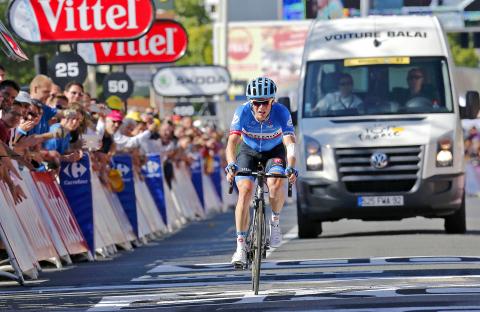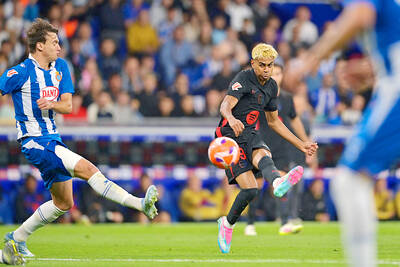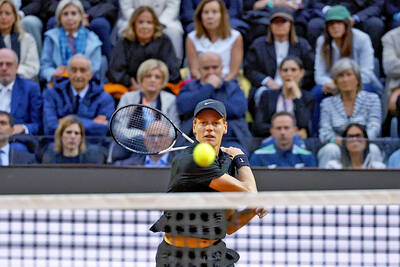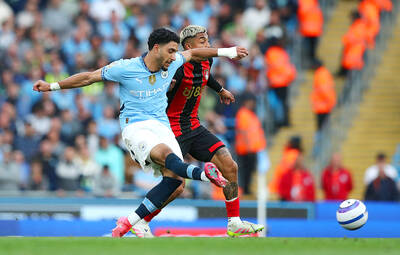US rider Andrew Talansky’s hopes of winning the Tour de France effectively vanished after two crashes last week, but he became another kind of cycling hero on Wednesday: The rider who would not quit when he probably should have.
Talansky started the 186km stage from Besancon with a prominent bandage on his right knee, a reminder of his dramatic crash near the finish in Nancy on Friday. Other scrapes, cuts and bruises were added to his body on Saturday when he became tangled with several other riders on a rainy descent.
By the end of Monday’s stage, Talansky, 25, was so stiff that he was unable to remove his jersey at the finish line without help from a team staff person.

Photo: Reuters
The masseurs and physiotherapists of Talansky’s Garmin-Sharp team spent Tuesday’s rest day attempting to get him back in form, but there was no miracle cure.
On the plus side, Wednesday’s race, unlike most of the cold, wet French stages of this year’s Tour, took place under sunny skies in summerlike temperatures.
However, when the pack sped up with about 82km remaining to the finish, Talansky, his pedaling somewhat labored, lost contact. Drifting backward he had a prolonged conversation with his team directors in a following car.
The conversation was inaudible on television, but the decision soon became apparent. Talansky pressed on, even though he soon fell behind even the long tail of team cars, official vehicles and media cars that drag along behind the race.
That left him painfully alone. His only company was a team car, a TV motorbike and the broom wagon — the van that sweeps up riders who abandon the race, but who do not get into a team car.
French TV frequently switched between the action at the increasingly distant front of the race and Talansky’s odyssey. In case anyone forgot why he was suffering, the broadcast often split the screen to rerun images of Talansky’s crash in Nancy.
After continuing for about 48km, it appeared that Talansky might have had enough. He dismounted, unable to stand up straight because of his stiff back. He carefully leaned his bike against a metal guard rail and sat down. Minutes passed as Talansky and his team director, Robbie Hunter, talked.
“I’d never encourage a person to get off their bike,” Hunter, a former rider, said later. “I myself have been in a position where I’ve stopped Tour de Frances previously and a couple of hours later I regretted it. The only thing I said to Andrew is: ‘If you’re going to stop, make sure it’s the right decision.’”
Talansky, still obviously in pain and crying, remounted his bike and continued at a steady pace, with Hunter shouting encouragement from the car.
“He got the emotion out of it and that kind of thing, and thought about it for a couple of seconds and decided to continue to get to the finish,” Hunter said.
Though racing the Tour while injured is usually not doctor-recommended, it is widely applauded by fans. One of the most famous episodes came in 1983 when French rider Pascal Simon fractured his shoulder blade while wearing the race leader’s yellow jersey. He pressed on, pushed up hills by teammates for five days before quitting the race. He remains as well-known in France for his perseverance as many riders are for winning the Tour.
In 2003, Tyler Hamilton, a US rider who was later disgraced for doping, continued to ride in the Tour with a broken collarbone.
Tony Gallopin, a French rider for Lotto Belisol, won his second stage of this Tour, a solo victory that was so tight that the 36 riders behind him were given the same time.
Talansky now faced a deadline. Under the Tour’s time elimination rule, he had to cross the finish line 37 minutes, 17 seconds later, or he would not be allowed to start yesterday.
As the digital clock ticked on, the day’s awards were given to Gallopin; the race leader, Vincenzo Nibali; and assorted other riders. The crowd began to wander off. Some fans heeded the announcer’s call over loudspeakers to remain and honor Talansky’s courage.
Ashen-faced, Talansky crossed the line 32:05 after Gallopin, receiving loud cheers from the spectators who stuck it out.
As one team official ran ahead to clear a path through the milling spectators swarming the road, another pushed Talansky to the team bus. To add to his misfortune, the bus was second to last in a long line of buses that stretched for about three blocks from the finish.
Talansky stiffly dismounted directly from his bike onto the stairwell of the bus. As its door swiftly swung shut, through its window it was apparent that Talansky could not climb the stairs until a team official reached down and pulled him up.
Minutes later he emerged to a crush of cameras and reporters and said that he had continued for his teammates “after all they’ve done for me.”
The American was unable to continue racing yesterday due to acute sacroilitis — an inflammation of the sacroiliac joint, which connects the iliac bone, in the pelvis, to the spine. He wished his teammates all the best and withdrew.

SSC Napoli will have to wait one more week to seal the Serie A title after on Sunday being held to a goalless draw at Parma, while closest rivals Inter drew 2-2 in a dramatic game with SS Lazio. Antonio Conte’s team stayed one point ahead of Inter and were unfortunate not to win after twice striking the woodwork through Andre-Frank Zambo Anguissa and Matteo Politano, while Scott McTominay also had a free-kick tipped onto the crossbar. The away side thought they would be handed a chance to take the points from the penalty spot in the 96th minute when David Neres

A stunning Lamine Yamal strike on Thursday helped crown Barcelona La Liga champions with a 2-0 win over local rivals RCD Espanyol, with victory ensuring Real Madrid cannot catch them at the top of the table. Yamal’s effort and Fermin Lopez’s goal took Hansi Flick’s side seven points clear of Los Blancos with two matches remaining, to clinch Barcelona’s 28th title and complete a superb domestic treble. Only the UEFA Champions League title escaped an exciting young Barca side this season, as they won the league for the second time in six years, at Espanyol’s ground again just as in 2022-2023. Back then,

Jannik Sinner on Thursday marched into the semi-finals of the Italian Open after destroying Casper Ruud in straight sets 6-0, 6-1, while Coco Gauff won a marathon three-set battle with China’s Zheng Qinwen to advance to the women’s singles final. American Gauff is to face Italy’s Jasmine Paolini in today’s title match after pulling through 7-6 (7/3), 4-6, 7-6 (7/4) in a match that lasted over three-and-a-half hours. Ruud was supposed to be Sinner’s toughest test in Rome since he came back from his three-month doping ban, as the Norwegian came into the match in hot form on clay after winning in

Omar Marmoush’s stunning long-range strike on Tuesday upstaged Kevin de Bruyne on the Manchester City great’s Etihad farewell. Marmoush let fly from about 30m to put City ahead in their 3-1 win against AFC Bournemouth in the Premier League. The victory moved Pep Guardiola’s team up to third in the standings and left qualification for the UEFA Champions League in their own hands heading into the last round of the season. “It’s really important. To be in the Champions League after what happened [this season] will be really nice,” the City manager said. De Bruyne was making his final home appearance for City before